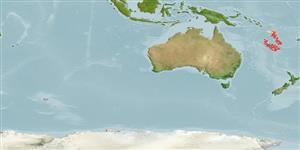Elasmobranchii (haaien en roggen) (sharks and rays) >
Carcharhiniformes (Ground sharks) >
Pentanchidae (Deepwater catsharks)
Etymology: Galeus: galeos, a small shark or dogfish according to Aristotle and others. (See ETYFish); priapus: Named for Priapos, Greek god of reproduction, referring to its long claspers. (See ETYFish).
More on authors: Séret & Last.
Environment: milieu / climate zone / depth range / distribution range
Ecologie
marien benthopelagisch; diepte 620 - 830 m (Ref. 76879). Subtropical; 13°S - 24°S, 163°E - 171°E (Ref. 76879)
Pacific Western Central: New Caledonia and Vanuatu. Known from the marginal slopes off southern New Caledonia, south of the Loyalty Islands Ridge and north of the Norfolk Ridge in 620–830 m depth and off Espiritu Santo Island (Vanuatu) in 262–352m depth (Ref. 76879).
Grootte / Gewicht / Leeftijd
Maturity: Lm ? range ? - ? cm
Max length : 44.6 cm TL mannelijk / geslacht onbekend; (Ref. 76879); 38.8 cm (female)
Korte beschrijving
Determinatiesleutels | Morfologie | Morfometrie
A small, slender Galeus with the following combination of characters: claspers extremely long
and slender in adult males, distal tips extending to near anal origin or beyond, their outer length 9.2–11.2% TL, 7.2–8.7 times base width; clasper without hooks or spiny denticles; exorhipidion greatly elongated, about 4 times spiracle length when fully developed; anterior inner margin of pelvic fin not fused to clasper; anal fin relatively small, length 9.8–12.0% TL; posterior anal-fin margin 4.7–5.9% TL, 1.4–1.8 in anterior margin of second dorsal fin; prepectoral length relatively short, about 17.8–19.4 %TL; labial furrows moderately long, not confined to mouth corners; enlarged denticle crest of upper caudal fin originating almost over origin of ventral caudal lobe, no abrupt demarcation between denticles of crest and those of caudal peduncle; denticles forming 2–5 central rows of denticles between larger oblique lateral rows near crest origin; no subcaudal crest; anterior margin of pectoral fin black; anterior half of dorsal fins almost entirely dark or dusky; precaudal centra 81–86 (Ref. 76879).
Levenscyclus en paargedrag
Maturities | Voortplanting | Spawnings | Egg(s) | Fecundities | Larven
Séret, B. and P.R. Last, 2008. Galeus priapus sp. nov., a new species of sawtail catsharks (Carcharhiniformes: Scyliorhinidae) from New Caledonia. Zootaxa 1813:19-28. (Ref. 76879)
Status op de Rode Lijst van het IUCN (Ref. 130435)
Gevaar voor de mens
Harmless
Gebruik door de mens
Tools
Speciale rapporten
Download XML
Internetbronnen
Estimates based on models
Preferred temperature (Ref.
123201): 5.6 - 6.8, mean 6.1 °C (based on 6 cells).
Fylogenetische diversiteitsindex (Ref.
82804): PD
50 = 0.5000 [Uniqueness, from 0.5 = low to 2.0 = high].
Bayesian length-weight: a=0.00355 (0.00176 - 0.00714), b=3.09 (2.91 - 3.27), in cm total length, based on LWR estimates for this (Sub)family-body shape (Ref.
93245).
Trofisch niveau (Ref.
69278): 4.0 ±0.2 se; based on size and trophs of closest relatives
Weerstandsvermogen (Ref.
120179): Hoog, minimale populatieverdubbelingstijd minder dan 15 maanden (Preliminary K or Fecundity.).
Fishing Vulnerability (Ref.
59153): Moderate vulnerability (39 of 100).
